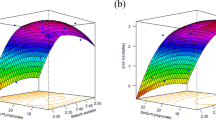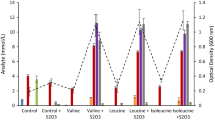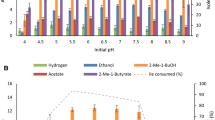Abstract
The anaerobic fatty acid-degrading syntrophic bacterium, Syntrophomonas wolfei, was grown in pure culture with either trans-2-pentenoate, trans-2-hexenoate, trans-3-hexenoate, and trans, trans-2,4-hexadienoate as the substrate. Trans-2-pentenoate was fermented to acetate, propionate, butyrate, and valerate. Acetate, butyrate, and hexanoate were produced from the six-carbon mono- and di-unsaturated acids. Propionate was also product from the trans,trans-2,4-hexadienoate which suggested this compound was degraded by another pathway in addition to β-oxidation. The transient production of trans-2-hexenoate from trans-3-hexenoate suggested that the position of the double bound shifted from carbon-3 to carbon-2 prior to β-oxidation. The specific growth rate decreased with increasing carbon length and degree of unsaturation. Molar growth yields ranged from 8.4 to 17.5 mg (dry wt.) per mmol and suggested that energy was conserved not only from substrate-level phosphorylation, but also from the reduction of unsaturated substrate.
Similar content being viewed by others
References
Ahring BK, Westermann P (1987) Thermophilic anaerobic degradation of butyrate by a butyrate-utilizing bacterium in coculture and triculture with methanogenic bacteria. Appl Environ Microbiol 53:429–433
Bader J, Günther H, Schleicher E, Simon H, Pohl S, Mannheim W (1980) Utilization of (E)-2-butenoate (crotonate) by Clostridium kluyveri and some other Clostridium species. Arch Microbiol 125:159–165
Balch WE, Wolfe RS (1976) New approach to the cultivation of methanogenic bacteria: 2-mercaptoethanesulfonic acid (HS-CoM)-dependent growth of Methanobacterium ruminantium in a pressurized atmosphere. Appl Environ Microbiol 32: 781–791
Beaty PS, McInerney MJ (1987) Growth of Syntrophomonas wolfei in pure culture on crotonate. Arch Microbiol 147:389–393
Boone DR, Bryant MP (1980) Propionate-degrading bacterium, Syntrophobacter wolinii sp. nov. gen. nov., from methanogenic ecosystems. Appl Environ Microbiol 40:626–632
Bryant MP (1972) Commentary on the Hungate technique for culture of anaerobic bacteria. Am J Clin Nutr 25:1324–1328
Emmanuel B (1978) The relative contribution of propionate, and long-chain even-numbered fatty acids to the production of longchain odd-numbered fatty acids in rumen bacteria. Biochim Biophys Acta 528:239–246
Hansen B, Bokranz M, Schönheit P, Kröger A (1988) ATP formation coupled to caffeate reduction by H2 in Acetobacterium woodii NZva 16. Arch Microbiol 150:447–451
Henson JM, Smith PH (1985) Isolation of a butyrate-utilizing bacterium in coculture with Methanobacterium thermoautotrophicum from a thermophilic digestor. Appl Environ Microbiol 49:1461–1466
Kemp P, White RW, Lander DJ (1975) The hydrogenation of unsaturated fatty acids by five bacterial isolates from the sheep rumen, including a new species. J Gen Microbiol 90: 100–114
Kenealy WR, Waselefesky DM (1985) Studies on the substrate range of Clostridium kluyveri; the use of propanol and succinate. Arch Microbiol 141:187–194
Kröger A (1978) Fumarate as terminal acceptor of phosphorylative electron transport. Biochim Biophys Acta 505:129–145
Krumholz LR, Bryant MP (1986) Eubacterium oxidoreducens sp. nov. requiring H2 or formate to degrade gallate, pyrogallol, phloroglucinol and quercetin. Arch Microbiol 144: 8–14
Laanbroek HJ, Abee T, Voogd IL (1982) Alcohol conversions by Desulfobulbus propionicus Lindhorst in the presence and absence of sulfate and hydrogen. Arch Microbiol 133:178–184
Lorowitz WH, Zhao H, Bryant MP (1989) Syntrophomonas wolfei subsp. saponavida subsp. nov., a long-chain fatty acid-degrading, anaerobic, syntrophic bacterium; Syntrophomonas wolfei subsp. wolfei subsp. nov.; and emended descriptions of the genus and species. Int J Syst Bacteriol 39:122–126
McInerney MJ (1988) Anaerobic hydrolysis and fermentation of fats and proteins. In: Zehnder AJB (ed) Biology of anaerobic microorganisms. John Wiley and Sons, New York, pp 373–415
McInerney MJ, Bryant MP (1980) Syntrophic associations of H2−utilizing methanogenic bacteria and H2−producing alcohol and fatty acid degrading bacteria in anaerobic degradation of organic matter. In: Gottschalk G, Pfennig N, Werner H (eds) Anaerobes and anaerobic infections. Gustav Fischer, Stuttgart, pp 117–126
McInerney MJ, Bryant MP, Pfennig N (1979) Anaerobic bacterium that degrades fatty acids in syntrophic association with methanogens. Arch Microbiol 122:129–135
McInerney MJ, Bryant MP, Hespell RB, Costerton JW (1981) Syntrophomonas wolfei gen. nov. sp. nov., and anaerobic, syntrophic, fatty acid-oxidizing bacterium. Appl Environ Microbiol 41:1029–1039
Polan CE, McNeill JJ, Tove SB (1964) Biohydrogenation of unsaturated fatty acids by rumen bacteria. J Bacteriol 88:1056–1064
Roy F, Samain E, Dubourguier HC, Albagnac G (1986) Syntrophomonas sapovorans sp. nov., a new obligately proton reducing anaerobe oxidizing saturated and unsaturated long chain fatty acids. Arch Microbiol 145:142–147
Samain E, Albagnac G, Dubourguier HC, Touzel JP (1982) Characterization of a new propionic acid bacterium that ferments ethanol and displays a growth factor dependent association with a Gram negative homoacetogen. FEMS Microbiol Lett 15: 69–74
Scheifinger CC, Wolin MJ (1973) Propionate formation from cellulose and soluble sugars by combined cultures of Bacteroides succinogenes and Selenomonas ruminantium. Appl Microbiol 26:789–795
Schink B, Pfennig N (1982) Propionigenium modestum gen. nov., sp. nov., a new, strictly anaerobic, nonsporing bacterium growing on succinate. Arch Microbiol 133:209–216
Schink B, Kremer DR, Hansen TA (1987) Pathway of propionate formation from ethanol on Pelobacter propionicus. Arch Microbiol 147:321–327
Schumann WC, Hemmelgarn E, Landau BR (1978) Omega-oxidation of fatty acids and the pathway of 3-hydroxybutyric acid formation. Arch Biochem Biophys 190:345–350
Sharak-Genthner BR, Davis CL, Bryant MP (1981) Features of rumen and sludge strains of Eubacterium limosum, a methanol- and H2−CO2−utilizing species. Appl Environ Microbiol 42:12–19
Shelton DR, Tiedje TM (1984) Isolation and partial characterization of bacteria in an anaerobic consortium that mineralizes 3-chlorbenzoic acid. Appl Environ Microbiol 48:840–848
Steib M, Schink B (1984) A new 3-hydroxybutyrate-fermenting anaerobe, Ilyobacter polytropus, gen. nov. sp. nov., possessing various fermentation pathways. Arch Microbiol 140:139–146
Steib M, Schink B (1985) Anaerobic oxidation of fatty acids by Clostridium bryantii sp. nov., a spore-forming, obligately syntrophic bacterium. Arch Microbiol 140:387–390
Stouthamer AH, Bettenhaussen C (1973) Utilization of energy for growth and maintenance in continuous and batch cultures of microorganisms. Biochim Biophys Acta 301:53–70
Thauer RK, Jungermann K, Henninger H, Wenning H, Decker K (1968) The energy metabolism of Clostridium kluyveri. Eur J Biochem 4:173–180
Wofford NQ, Beaty PS, McInerney MJ (1986) Preparation of cell-free extracts and the enzymes involved in fatty acid metabolism in Syntrophomonas wolfei J Bacteriol 167:179–185
Zinder SH, Koch M (1984) Non-aceticlastic methanogenesis from acetate: acetate oxidation by a thermophilic syntrophic coculture. Arch Microbiol 138:263–272
Zubay G (1983) Biochemistry. Addison-Wesley, Reading, Mass, pp 480–484
Author information
Authors and Affiliations
Rights and permissions
About this article
Cite this article
Amos, D.A., McInerney, M.J. Growth of Synthrophomonas wolfei on unsaturated short chain fatty acids. Arch. Microbiol. 154, 31–36 (1990). https://doi.org/10.1007/BF00249174
Received:
Accepted:
Issue Date:
DOI: https://doi.org/10.1007/BF00249174




